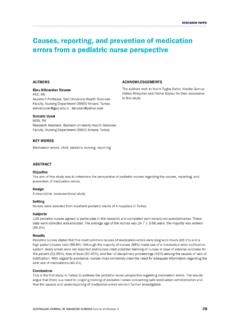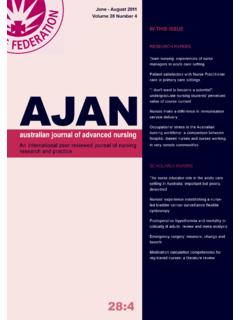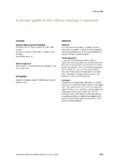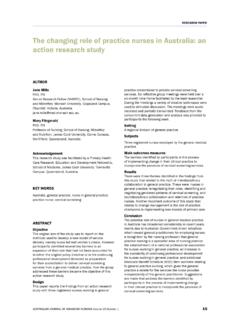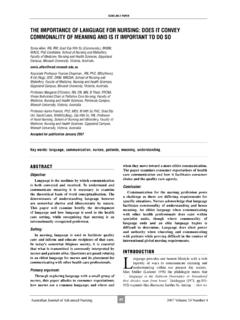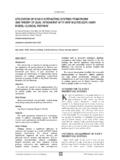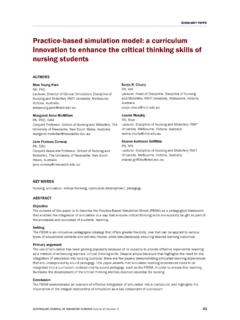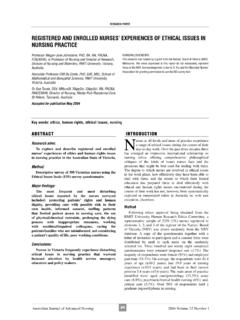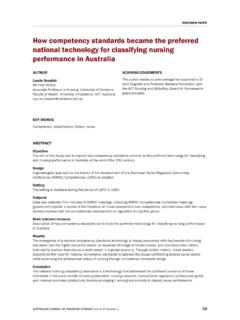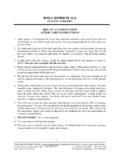Transcription of Enhancing the pre‑admission process for a patient with ...
1 AUSTRALIAN JOURNAL OF ADVANCED NURSING Volume 32 Number 130 SCHOLARLY PAPERE nhancing the pre admission process for a patient with breast cancer AUTHORDr Barbara NewmanRN; (Teach); Post Tropical Public Health; Post Graduate and Safety; MHPEd; PhD; FACN Assistant Professor, University of Canberra, ACT Australia. WORDS family, women with breast cancer, pre admission , nurse interventions and assessmentsABSTRACTO bjectiveThe purpose of this paper is to detail the development and implementation of a patient focused pre admission process , part of which is the check list identified within this paper and comprising the main point of the paper because it is based on patient and publication evidence for women with breast cancer.
2 Women with breast cancer together with health professionals had specific input into the designed pre- admission clinic at a tertiary care hospital. A pre admission clinic had been established some time ago however, women who attended this clinic deemed it most unsatisfactory for their needs. Results from an evaluation provided information that indicated women with breast cancer required an improved pre admission process that was aligned to their needs and those of the breast Cancer Multidisciplinary Team (BCMT). SettingA large tertiary care hospital in Sydney, New South Wales, Australia. SubjectsFifty (50) women of mixed cultures. Men can be diagnosed with breast cancer however, throughout this project, women were the only patients presenting for surgery.
3 Primary ArgumentEven though remarkable progress has been made in breast cancer survival through medical treatment, women, newly diagnosed with breast cancer are frequently concerned, stressed and anxious as they attempt to come to terms with the news on their cancer diagnosis. Beside the initial medical consultation that informs them on their diagnosis, the women s first major interaction with the healthcare system commences when they attend the pre- admission clinic as a pre admitted person. Therefore it is appropriate to examine current nursing practices during the pre admission phase of a Tertiary Hospital so women, newly diagnosed with breast cancer are able to receive appropriate and supportive care.
4 The goal of health professionals is to respect each patient and give voice to them by developing a specifically designed pre- admission process . It is expected any pre- admission process will utilise available evidence and include consultation with the breast Cancer Multidisciplinary Team (BCMT). Thus the project commenced by identifying the needs of women with breast cancer in consultation with the BCMT, including nurses, physiotherapists, doctors and social workers. This evidence based approach to best practice in the pre admission process and clinic has not been attempted previously for this cohort of patients . ConclusionImproving the pre admission process of patients encourages analysis of the evidence that is appropriate for this cohort and nursing practices.
5 In addition, it offered time to ensure applicability of the pre admission process and clinic to the lives of the women concerned. During this project opportunities arose for reflection on the journey women follow after their diagnosis and the involvement of the BCMT. Moreover, this process encouraged examination of the most appropriate allocation and use of resources within the context of the pre admission process and clinic, surgery, and discharge through to home follow up. This paper maps some of the adopted process , the collected data and briefly summarises resources utilised in relation to the pre- admission breast Cancer Nurse and Project Registered NurseThis project was part of a larger study funded by the New South Wales breast Cancer Institute, JOURNAL OF ADVANCED NURSING Volume 32 Number 131 SCHOLARLY PAPERBACKGROUNDA ccording to the Australian Institute of Health and Welfare (2012) there were 14,560 persons diagnosed with breast cancer in 2012, with 2,940 deaths resulting from breast cancer.
6 Those persons diagnosed early had an 89% chance of survival in a five year period compared to the general population. The risk factors for breast cancer continue to be, obesity and physical inactivity, family history and genetic susceptibility, diet, alcohol consumption, reproductive and hormonal factors, radiation and ageing (Australian Institute of Health and Welfare 2012). Therefore, the situation for women s life expectancy with early diagnosis of breast cancer has improved. However, the women s needs are substantial in view of the reality of their situation and the impact upon their lives and those of the family following a diagnosis of breast cancer, many women experience serious psychological distress; if not addressed early in the process , can adversely affect care and outcomes (Fox et al 2013).
7 Moreover, the perception and uncertainty about the diagnosis may be reduced at the completion of treatment (or its recurrence), creating even greater concerns about the effort to resume normal life. Family members become affected as well, mostly due to disruption within the family unit. In facing these challenges, women seek new strategies to live with the disease (Tritter and Calnan 2002), which manages short and long term psychosocial aspects of the diagnosis, and the many consequences (Eley and Rogers Clark 2012). These include potential treatments, such as chemo therapy and/or radiation therapy and concern about the cancers recurrence, intervention and treatment can impact on many aspects of life and living with family.
8 An editorial by Saeki (2013), from which the question is asked Do we ask? Do we listen? where this author laments on the infrequency of speaking with patients , of asking them questions about their care and wishes. Today nurses must embrace evidence that assists them to understand the array of personal meaning contexts that influence patient values and therefore patient decisions, given the situation they find themselves in and the context (Grace and Powers 2009). Studies about the nurse-doctor contribution suggest that women, in particular are more satisfied with nursing care (Corner 2002). Nurses tend to demonstrate this through good communication which has long been recognised for achieving immediate goals and contributing to the patient s wellbeing and recovery (Major and Holmes 2008).
9 Pearce (1941 n ) stated, ..a nurse with the gift of making her patients feel at home and free from fear, inspires confidence and provides an atmosphere of peace, serenity and security which is so important an adjunct to the relaxation of mind and body necessary for recovery from disease patients and families are not expecting a diagnosis of breast cancer as illness is not present in the same way as other disease processes, for example heart disease, diabetes or stroke. Shock and concern becomes an inherent part of the journey, particularly when the diagnosis of cancer involves ..chronic illness and the potential to produce pain, and disabling of physical activity (Tritter and Calnan 2002).
10 This includes fear of the unknown, which must be confronted on a daily basis. As a consequence of these concerns, a patient focused, pre admission process in a tertiary level hospital with expert nurses must involve the family. Nurses understand both patient and family by meeting the women in the pre admission clinic, and then following each one (Bergman et al 2013) towards a state of wellness. In fact, Ke et al (2012) and Eley and Rogers Clark( 2012) acknowledge the importance of funding programs in a centralised system of teaching hospitals due to the availability of specialists services in most Australian cities. This saves money and contributes to whole of family care.

